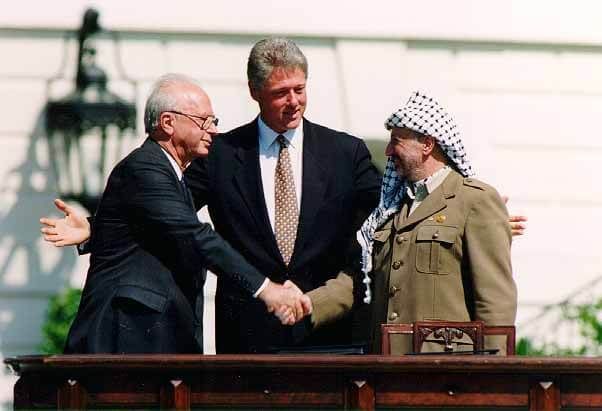Israel has faced significant criticism for allegedly not trying to make peace with the Palestinians who live in the Holy Land. But the Oslo Accords prove that this is simply not the case.
Israeli and Palestinian leaders met secretly in Oslo, Norway and reached agreements signed in 1993 (at the White House) and 1995 (in Taba, Egypt) in which the Palestine Liberation Organization formally recognized the right of the State of Israel to exist in place of its previous call for its destruction, while Israel recognized the PLO as the representative of the Palestinian people as opposed to a terror organization which it refused to negotiate with.
Join the fight for Israel’s fair coverage in the news
The “Oslo Accords” viewed peace between Israel and the Palestinians as a process which would be implemented in incremental steps. The first step was the creation of an entity called the Palestinian Authority and its Palestinian Legislative Council which would have self-governance in part of the West Bank and the Gaza Strip.
Notably, the Oslo Accords did not call for the creation of a sovereign Palestinian state.
The West Bank was divided into three areas: Area A, 18% of the West Bank which includes all the major Palestinian towns, with no Israeli civilian presence, would be under the full civilian and security control of the Palestinian Authority. Area B, 22% of the West Bank which includes less built-up Palestinian areas in close proximity to Israeli settlements but with no Israeli civilian presence in the area, would be under the civil control of the PA but Israel’s security control. Area C, 60% of the West Bank where hundreds of thousands of Israelis live, would be under full Israeli control. The concept was for as many Palestinians as possible to live under Palestinian control and for the Israelis living in the West Bank to be under Israeli control, with Israel also providing security for Israel proper.
Related reading: Do You Know Your Area A, B and C?
Israel agreed to withdraw its military gradually from Palestinian areas and to transfer security responsibility of those areas to the Palestinian Legislative Council and the Palestinian Authority police.
Article XI.2.e states:
During the further redeployment phases to be completed within 18 months from the date of the inauguration of the Council, powers and responsibilities relating to territory will be transferred gradually to Palestinian jurisdiction that will cover West Bank and Gaza Strip territory, except for the issues that will be negotiated in the permanent status negotiations.
The issues that would need to be negotiated in the future were identified as “Jerusalem, settlements, specified military locations, Palestinian refugees, borders, foreign relations and Israelis; and … powers and responsibilities not transferred to the Council.” The negotiations regarding these final status issues were to be concluded before May 1999.
According to the Accords, Israel which was wary about handing over full security control to an entity which was sworn to its destruction for decades, and with terrorist entities surrounding the Holy Land, maintained control of the borders, the airspace and waters. Oslo II, Article XII states:
Israel shall continue to carry the responsibility for defense against external threats, including the responsibility for protecting the Egyptian and Jordanian borders, and for defense against external threats from the sea and from the air, as well as the responsibility for overall security of Israelis and Settlements, for the purpose of safeguarding their internal security and public order, and will have all the powers to take the steps necessary to meet this responsibility.
The first proactive step according to the agreement was Israel partially withdrawing from Gaza and Jericho. They would then transfer some powers on civil issues to the interim Palestinian Authority. Israeli troops would then withdraw from other Palestinian areas and elections would be held for the Palestinian Legislative Council.

Israel withdrew from Jericho and from most of the Gaza Strip in 1994 and the first elections for the Palestinian Legislative Council (PLC) took place on January 20, 1996. The governments elected by the PLC retained the name “Palestinian National Authority.”
But in May 1999, the five year interim period ended with the two sides not reaching a comprehensive peace agreement. Some elements of the Oslo Accords remained such as the division of the three areas. The interim Palestinian Authority became permanent, and a dominant component of the PLO. The 2000 Camp David Accords were an attempt to revive the negotiations and save the Oslo Accords. But when the Palestinians refused the Israeli offer, the Second Intifada was unleashed, using many of the weapons the Palestinians were given for their own security forces, bringing the process to an end. During the Second Intifada, IDF forces had to reoccupy many of the areas which it turned over to the Palestinians because they became platforms for terror attacks against Israel.
The Israeli public entered the 1990s with a feeling of hope that perhaps there could be a breakthrough and that peace could be achieved with the Palestinians. But the failure of the two sides to come to a final arrangement which provided Israel with its security needs – especially amidst continued terror attacks during the process – led to the stalemate between the two which exists until today.
Liked this article? Follow HonestReporting on Twitter, Facebook, Instagram and TikTok to see even more posts and videos debunking news bias and smears, as well as other content explaining what’s really going on in Israel and the region.
New! Skip the social scroll and get the latest from HonestReporting via Telegram.

